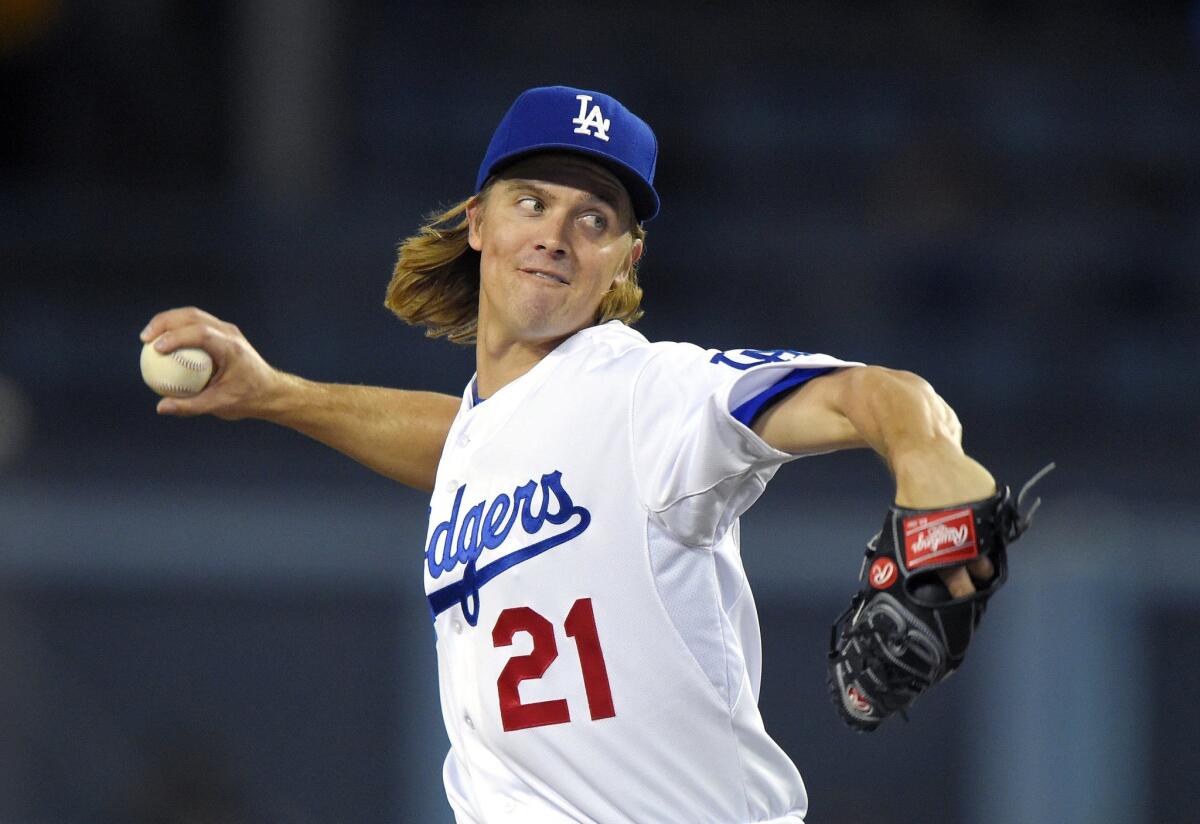Forget the Zack Greinke deal. Major league ballplayers are getting ripped off.

Zack Greinke is baseball’s newest plutocrat (and no longer a Dodger). What does his rich deal tell us about the U.S. economy?
A few high-profile free-agent signings can mislead even the most devoted sports fan into thinking that the average ballplayer has things pretty sweet. Case in point: the six-year, $206.5-million deal with the Arizona Diamondbacks that makes ex-Dodgers ace Zack Greinke, at the age of 32, the best-paid player in the game by annual average.
To Paul Campos of the Lawyers, Guns & Money blog, this also makes Greinke a gold-plated illustration of how wages are distributed throughout the economy in the new gilded age. He’s right. While Greinke’s deal is sucking up all the attention at the moment, what’s getting overlooked is that ballplayers on average are receiving a shrinking percentage of total Major League Baseball revenues. Who’s getting more? The owners, of course.
The players’ “plummeting share of overall MLB league revenues,” writes Nathaniel Grow of the University of Georgia on FanGraphs, is a “significant and pressing -- but often overlooked -- issue” that the MLB Players Assn. should take up with the owners at the next round of contract negotiations, which will follow the 2016 season.
After peaking at a little more than 56% in 2002, today MLB player salaries account for less than 40% of league revenues, a decline of nearly 33% in just 12 years.
— Nathaniel Grow, University of Georgia
As Grow observes, “after peaking at a little more than 56% in 2002, today MLB player salaries account for less than 40% of league revenues, a decline of nearly 33% in just 12 years.” He offers several explanations.
One is that after years of resisting a salary cap, the players union allowed one to sneak in via the back door. The luxury tax charges teams up to 50 cents for every dollar of payroll over $189 million, Grow observes. Meanwhile, the league’s revenue-sharing rules now require teams to share 31% of their locally-generated revenues with each other. That means, he writes, that large-market teams have become “less willing to invest in their on-field product, since they now retain a smaller portion of any additional in-stadium revenues that they generate.”
(He might have noted, too, the 2010 passing of New York Yankees owner George Steinbrenner, whose free-spending ways showed the league the relevance of the spend-money-to-make-money principle and also inspired more interest in the luxury tax.)
Although the whole point of revenue-sharing and the luxury tax was to give small-market teams more money to compete on the field, this effect hasn’t surfaced -- the smaller teams are still as cheeseparing as ever, so their roster players continue to be underpaid.
The last factor Grow identifies is the increasing primacy of national television revenue -- more than $12 billion in eight-year deals reached with Fox Sports, Turner Broadcasting and ESPN in 2012, more than double the previous contracts. There are no incentive clauses requiring that any of these revenues be spent on the on-field product; it’s equally distributed among all 30 teams, whether they soar or stink, so, to the average owner, there’s no reason to cut the players in.
Let’s not forget that in baseball, like most pro sports, the connection between player salaries and performance can seem awfully tenuous, especially when performance is broken down year by year. The 2015 World Series teams were decidedly from the second division, payroll-wise: On opening day, the Kansas City Royals ranked 16th out of 30, with $113.6 million, and the New York Mets 21st, at $101.4 million.
Of the top five payrolls, the Los Angeles Dodgers (No. 1, $272.8 million) washed out in the division series, the Yankees (No. 2, $219.3 million) lost their wild-card game, the Boston Red Sox and Detroit Tigers (No. 3 and No. 4) landed last in their divisions, and the San Francisco Giants (No. 5), came in second in their division to the Dodgers, eight games back.
The vagaries of daily play sometimes make it hard to connect a player’s quality to his salary, especially as he ages and especially (are you listening, Diamondbacks?) if he’s a pitcher. It’s easy to forget that making an MLB roster automatically places an athlete among the best 750 workers in the world plying his trade. (All right, during the 40-man roster expansion in late season, call it the best 1,200 in the world.)
They’re elite, and even the worst of them is paid that way, especially considering that most of them are finished by their early 30s. It’s tempting to measure them, however, inning by inning. You know the drill. Multimillionaire free-agent slugger whiffs at the plate in a clutch situation, and he’s a bum. Forget that .320 batting average and .550 slugging percentage. What has he done for us lately?
The disparity between a handful of superstars and the mass of journeymen isn’t new. It’s just that there are a few more superstars and the distance between them and the rest has widened. Babe Ruth collected $70,000 (about $1 million in today’s money) as a member of the 1927 Yankees, considered to be perhaps the greatest team ever fielded; Lou Gehrig, who hit .373, got $8,000.
Back in 1997, a study at the Bureau of Labor Statistics, of all places, noticed that “enormous paychecks” were the exception in baseball, amid a “polarization of team salaries.” The median salary was three-quarters of the mean in 1970; by 1996, it had fallen to about 27% as a few big name free-agents sucked up the cash, leaving less for everyone else. Today it’s about one-third of the mean.
The most fascinating aspect of Grow’s analysis is his finding that players have been getting rooked in all major sports -- in 2001, payroll consumed 50% of league revenues in pro baseball, football and basketball; today they’re all at less than 43%. “Rather remarkably, MLB players went from receiving the highest share of overall league revenue in the three sports in 2003 to the lowest just 10 years later.”
What’s the solution? Grow recommends that the MLB Players Assn. seek a salary cap, but peg it to a set percentage of league revenues, presumably much higher than 43% or even 50%. A better option, he says, might be to seek a salary floor. Rather than endorse a salary cap, then, the more attractive option for the MLBPA may be to seek a salary floor, a minimum share of revenues that each team must spend on payroll. That way, “the players would be able to ensure that they will receive a consistent percentage of MLB’s growing profits.”
Fans might be inclined to view this battle as merely one between plutocrats, but that’s a mistake. Except in relative terms, there’s no difference between what’s happening in pro sports and in the economy at large: The ownership class is taking more, and leaving the employees with less.
Keep up to date with Michael Hiltzik. Follow @hiltzikm on Twitter, see his Facebook page, or email michael.hiltzik@latimes.com.
MORE FROM MICHAEL HILTZIK:
The attack on climate change scientists continues in Washington
What George F. Will gets wrong about the progressive income tax
Solving the inversion crisis: How the U.S. can keep companies at home
More to Read
Inside the business of entertainment
The Wide Shot brings you news, analysis and insights on everything from streaming wars to production — and what it all means for the future.
You may occasionally receive promotional content from the Los Angeles Times.











